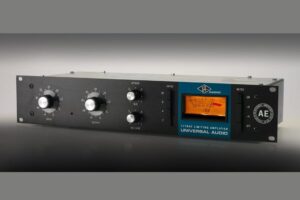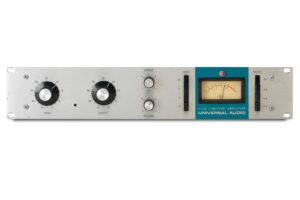As music producers, we often find ourselves amazed by the unique sound of compressors like the LA-2A and 1176.

Sometimes, we wonder why we are drawn to them and why they consistently deliver exceptional vocals.
Well, the truth is that we love these compressors because of our good taste in music. Music also triggers nostalgic memories, creating a sense of familiarity and emotional connection.
In this article, we will explore the LA2A and the 1176 compressors. We will specifically focus on exploring their unique qualities and understand their impact on vocal recordings.
After reading this article, you’ll know when to choose either LA2A or 1176 for vocals. You’ll also learn how these legendary compressors can enhance your vocal tracks.
Contents
The LA2A vs. 1176 Comparison – Overview
We begin with the LA-2A, a highly revered compressor that has found a home in recording studios and radio stations worldwide.
It has warm and smooth compression characteristics, making it a household name in the audio industry.
In the world of radio broadcasts, the LA-2A has played an important role in shaping the voices of radio personalities.
In the process, it has helped broadcasters achieve a polished and broadcast-ready sound.
Unlike the LA-2A, the 1176 is a classic FET (Field-Effect Transistor) that is known for its versatility and aggressive compression characteristics.
For one thing, it is also known for its iconic black faceplate.
It is the preferred choice of compressors for some and a go-to choice for several audio engineers across various genres.
The LA2A vs. 1176 Comparison – Features
To understand the unique qualities of the LA-2A and the 1176, it’s essential to understand their underlying technology.
The LA-2A utilizes a specific type of compression known as opto compression. This compression technique relies on a small light bulb within the circuit.
As more voltage passes through the bulb, it becomes brighter, activating a photo optic cell.
The amount of light the cell detects determines the compression level applied. It has a fascinating circuit that imparts a characteristic smoothness to the audio.
One key feature of the LA-2A is that it offers limited control over the compression process.
Unlike the 1176, the LA-2A’s compression characteristics are tied to the voltage passing through the light bulb.
As a result, the LA-2A excels at maintaining consistent and gentle compression over a longer period.
The feature makes it ideal for slow songs, vocals, and instruments with less transient content.
The 1176, on the other hand, offers a wider range of adjustable parameters compared to the LA-2A.
Its design makes allowance for greater control of the compression process. One key feature is its ability to adjust the attack and release times.
It helps to determine how quickly the compression engages and disengages. This flexibility allows audio engineers to shape the audio source’s dynamics more precisely.
The 1176’s FET-based design contributes to its unique sound. FET compressors are known for their fast response time and aggressive compression characteristics.
This feature makes the 1176 compressor well-suited for situations where a more pronounced and upfront compression is required.
It can quickly react to transient and control peaks, making it a popular choice for capturing the energy of rock vocals.
The LA2A vs. 1176 Comparison – Vocal Ability

Now, let’s talk about the vocal recordings from both the LA-2A and the 1176 compressors.
The LA-2A’s ability to smooth out dynamic fluctuations and control peaks makes it an excellent choice for vocals.
The LA-2A’s gentle compression helps to maintain a consistent vocal level.
This consistent level ensures that softer passages remain audible without sacrificing the impact of louder moments.
Its warmth and smoothness contribute to a polished and professional vocal sound.
It is important to note that the LA-2A may not be the best choice for every situation.
When applied to hihat (high-hats), the LA-2A can lose clarity and definition, coating the sound and reducing its impact.
It is better applied to situations where a gentle and consistent compression is desired. It also works where the source material does not hold fast transients or excessive attack.
The 1176 can add a lively and energetic quality to any audio recording or sound. Its fast attack time allows it to react quickly to vocal transients.
It also ensures that the peaks are controlled and the vocals are consistent. The 1176’s aggressive nature can add excitement and presence to vocals.
It’s also worth noting that the 1176 may not be the ideal choice for every vocal scenario.
Its aggressive characteristics may not be suitable for softer or more intimate vocal performances where a gentler touch is desired.
In these cases, the LA-2A’s smoothness and transparency may be a better fit.
However, for music genres that call for a more energetic and upfront vocal sound, the 1176 is a better fit.
The LA2A vs. 1176 Comparison – Compression and Dynamic Range
When talking about vocals, dynamic range refers to the difference between the loudest and softest parts of a sound.
Imagine a room with high ceilings—the highest point represents the loudest sound, while the floor represents the softest sound.
When we apply compression, it is as if we are lowering the ceiling of the room. As a result, everything in the room feels larger, as the dynamic range has been reduced.
Conversely, when the ceiling is raised, the lower parts of the room appear taller because they are closer to the new ceiling.
Compression works in a similar way, reducing the space in which the audio’s voltage can travel.
By reducing the dynamic range, compression brings the louder and softer elements of the audio closer together in volume.

This gives the impression that the loud sounds have become softer and the soft sounds have become louder.
The LA-2A, with its gentle touch, preserves the dynamic nuances of sound while reigning in any unruly peaks.
Its opto compression design eliminates inconsistencies and adds a touch of warmth and character to vocals.
Imagine it as a sonic caress that takes care of the dynamics while maintaining the natural flow of the performance.
On the other hand, the 1176 bursts onto the scene with its bold and aggressive compression.
Its lightning-fast attack times ensure that transients are swiftly controlled, providing a tighter and more controlled sound.
It’s like a sonic superhero that adds punch and excitement to vocals, drums, and other dynamic sources.
Deciding between the LA-2A and the 1176 depends on the desired sonic characteristics you want to achieve.
If you want a compressor that delicately sculpts the dynamics, keeping things smooth and transparent, choose the LA-2A.
Its gentle and musical compression is perfect for preserving the natural dynamics are paramount.
Looking for something with more grit and attitude? Choose the 1176! Its fast attack times and energetic compression can add excitement and intensity to your mix.
Don’t be discouraged if you don’t fully understand compression right away or even after weeks or months of practice. Embrace the learning process and continue experimenting.
Remember, compression is a powerful tool, and with time and experience, you’ll develop a deeper understanding of its intricacies.
Wrap Up
On a final note, when you’re on the journey of exploring compression, let your ears guide you.
With time, practice, and a willingness to learn, you’ll unlock the true potential of these remarkable compressors.
There are no strict rules when it comes to compression. Every sound and mix is unique, and experimentation is key.






